
 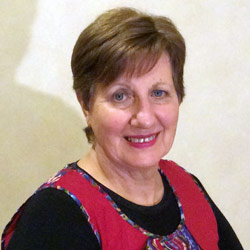 Hello.
My name is Edith Morris. This website is a place to find information
about polio and Post Polio Syndrome for people who had polio, family
members and carers. The items are selections I have gathered from a
variety of other sites, my own observations and experiences on my polio
journey, and polio news from within New Zealand. Some of the insights I
gained from my time as president of Polio NZ Inc (2008-2014) will be
offered as opinion pieces from time to time. Hello.
My name is Edith Morris. This website is a place to find information
about polio and Post Polio Syndrome for people who had polio, family
members and carers. The items are selections I have gathered from a
variety of other sites, my own observations and experiences on my polio
journey, and polio news from within New Zealand. Some of the insights I
gained from my time as president of Polio NZ Inc (2008-2014) will be
offered as opinion pieces from time to time. |
STORIES FROM 2015
|
|
Thank You Dr Salk - Polio Vaccine Hero 60 year anniversary of the Salk Vaccine. 1955 - 2015 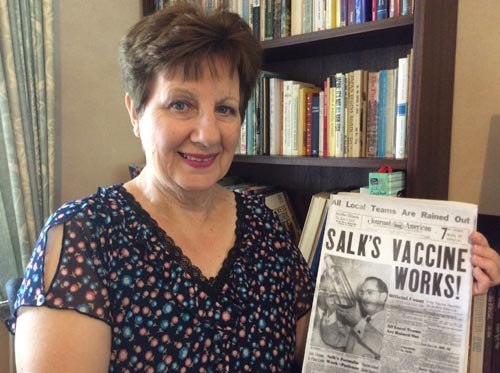 Bold
newspaper headlines read: “Salk’s Vaccine Works, Polio Routed! Vaccine
Triumph Ends Polio Threat.“ The first official public announcement that
the polio vaccine was “safe, effective and potent” was made on the 12th
of April 1955 in America. Can we imagine the rapturous joy, excitement
and pure relief that one of the most crippling and terrifying diseases
could now be conquered? Radio, TV, newspapers, public address systems
in schools, factories and work-places, and ringing church bells shouted
out across the nation that the Salk vaccine was successful. Huge crowds
went wild as they gathered in the streets and around wireless sets to
absorb this historic announcement. That day was also appropriately the
10th anniversary of the death of America’s polio president F D
Roosevelt.
In just the two years before the vaccine, polio cases in the US numbered more than 45,000, but by 1962 the number was down to 910, and in 1994 USA was declared polio free. Here in New Zealand the records of how many contracted polio are not so clear or accurate. Between 1915 and the last polio epidemic in 1961 an estimated 10,000 people were registered, however many others went unreported. The first batch of Salk polio vaccines arrived here in April 1956. A small group of 8-9 year old school children were the first to be immunised. In 2000 New Zealand was declared polio free and this once-feared, dreaded disease has almost disappeared from our national psyche, thanks to Jonas Salk and Albert Sabin. The cultural and social impact of preventing regular epidemics of polio was enormous. The fear of wondering which child would be next to succumb to infantile paralysis, was lifted. Citizens could once again gather freely at churches, movie theatres, swimming pools, sports events and schools without wondering if there were any contagious carriers of the polio virus amongst them. This was the vaccine everyone wanted. 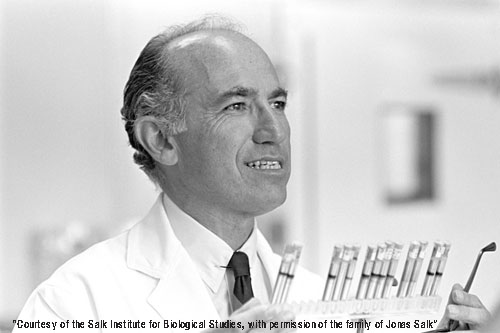 The development of the polio vaccine by Jonas Salk and his team of researchers is one of the greatest medical breakthroughs in modern times, in my opinion. I contracted polio at the age of six months in 1945 (ten years before the vaccine) and continue to live with the after effects of a lifetime of polio damage to my body. Apart from the obvious physical effects, the emotional harm of isolation, hospitalisation, rejection and the super human effort of trying to live a so-called “normal” life with polio have left their marks too. Yet when I look at my family and hug my grandsons, one named Jonas, what else can I say but “Thank you Jonas Salk. My family need never be touched by polio.” In this modern era, there is absolutely no reason for anyone to be infected with the polio virus. It is so important to keep vaccination levels up in New Zealand because low levels could mean that a polio epidemic could be only a plane ride away. Total global eradication of polio is a continuing pursuit by Rotary, the Bill & Melinda Gates Foundation, and the World Health Organisation. Access to war torn countries is slowing down the efforts of these and other groups desiring to protect the most vulnerable in the population: children. Jonas Salk never patented his polio vaccine, saying “There is no patent. Could you patent the sun?” And he also said “hope lies in dreams, in imagination and in the courage of those who dare to make dreams into reality”. Thank you Dr Jonas Salk that your dreams of a polio vaccine became a reality. Edith Morris Polio Survivor   The
first ever Australasia-Pacific Post-Polio Conference – “Polio: Life
Stage Matters” – to be held in Sydney in September 2016 will facilitate
better care and build international connections by bringing together
health care providers, researchers, polio survivors, their caregivers
and patient organisation representatives not only from the
Australasia-Pacific region, but worldwide.
more info hereShow Your Ability – Hamilton Report 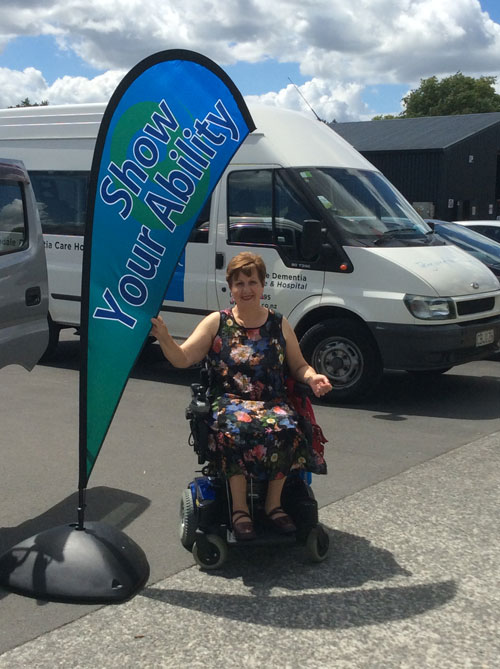  But I was drawn to a particularly simple piece of equipment that I hadn’t seen in other years. It was a Bounce Pod, a B Pod, a low, small trampoline for exercising. The surrounding handle bars give support for those unsteady on their feet. I got 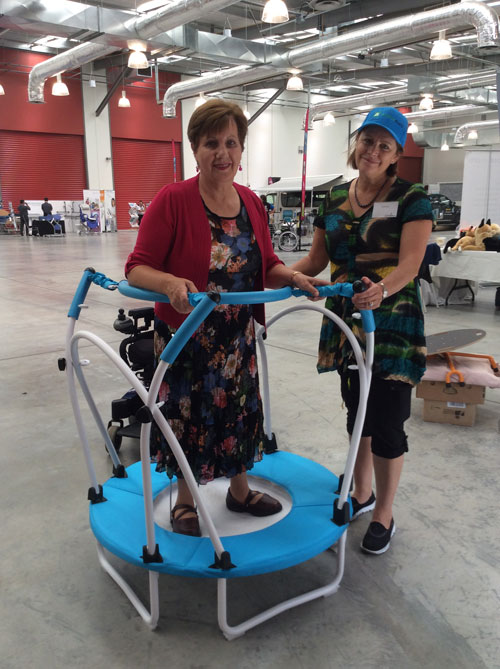 out
of my wheelchair and stepped onto the low trampoline by holding the
hand grips, and after a few tentative steps felt quite secure.
Immediately I felt the gently bouncing I could see the benefit of the
total body jiggling exercise. Even with a brace on one leg I felt safe. Later I was intrigued to see an amputee friend trying it out and she made the comment that the bouncing movement
was gently on her prosthesis. The pamphlet shows that even a wheelchair
can be lifted onto the B Pod and the person (and wheelchair) bouncing
as vigorously or gently as they liked. I’m keen to look into this
device some more. out
of my wheelchair and stepped onto the low trampoline by holding the
hand grips, and after a few tentative steps felt quite secure.
Immediately I felt the gently bouncing I could see the benefit of the
total body jiggling exercise. Even with a brace on one leg I felt safe. Later I was intrigued to see an amputee friend trying it out and she made the comment that the bouncing movement
was gently on her prosthesis. The pamphlet shows that even a wheelchair
can be lifted onto the B Pod and the person (and wheelchair) bouncing
as vigorously or gently as they liked. I’m keen to look into this
device some more.see www.activefun.com.hk  The ReWalk Robotic suit was demonstrated by Theresa Hannigan, a US Army Sergeant who has used a wheelchair for mobility since 2001. It was fascinating to watch the robotic frame being strapped onto her legs, see her rise up off a chair, stand up with the help of sticks, press a button on her wrist communicator, and then see the motorised legs move her useless legs across the exhibition hall. 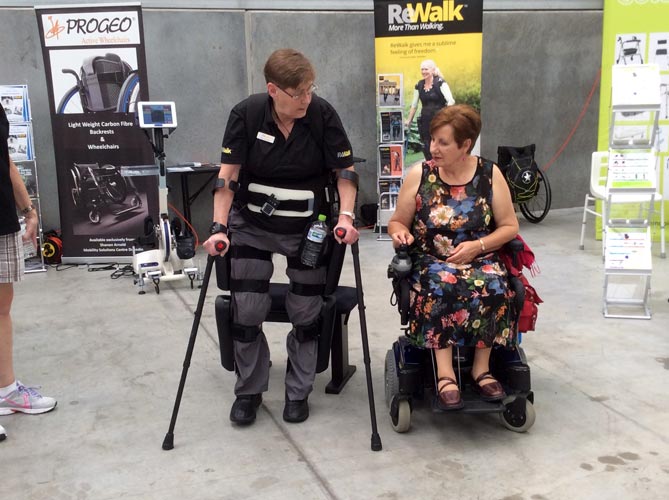 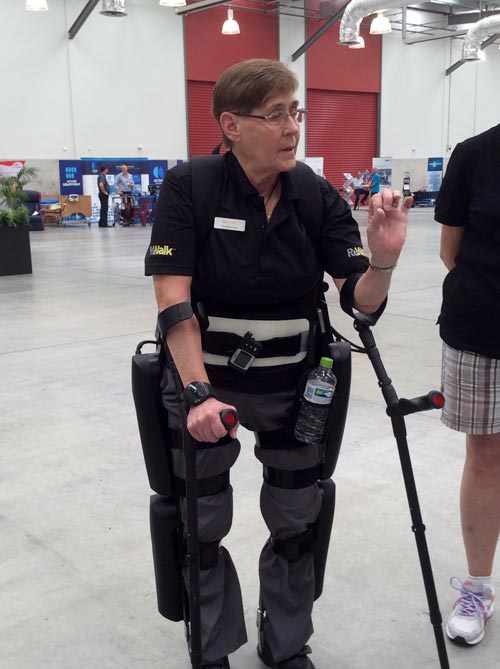 I didn’t get wildly excited about it as the cost was the price of a small house and the whole appearance of the robotic suit looked rather “space alien.” In another few years when the developers have refined the mechanics so the wearer didn’t have a heavy computer and batteries in a backpack and wide leg attachments, (currently weighing about 23 kilos) the invention may be more appealing. Around 50 people world-wide use this device. see www.rewalk.co.nz or wikipedia. 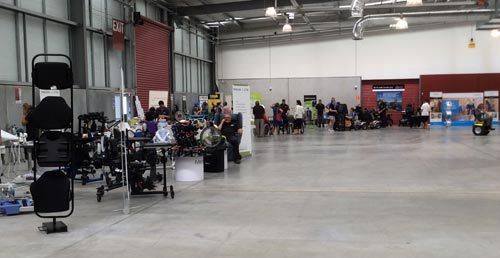 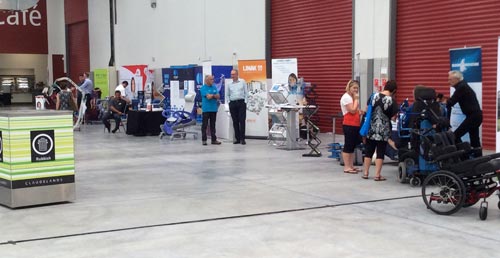 The Vaccine Everyone Wanted Jennifer Latson Feb. 23, 2015 TIME MAGAZINE Feb. 23, 1954: The first mass inoculation of children against polio with the Salk vaccine takes place, in Pittsburgh
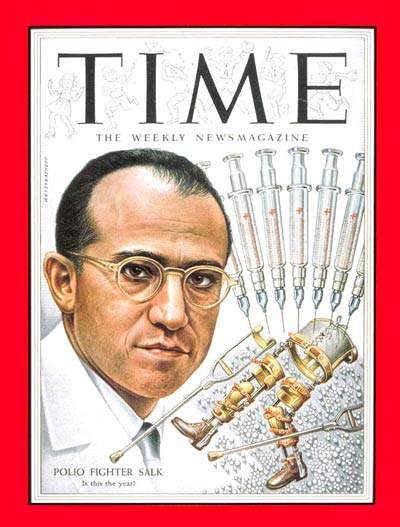 In the midst of the contentious debate between anti-vaxxers and those who side with mainstream science, it can be hard to imagine a time when Americans almost universally embraced vaccination. That time was the 1950s, when the very real, utterly devastating effects of polio overshadowed any hypothetical questions of vaccine safety. In 1952, the worst polio outbreak in American history infected 58,000 people, killing more than 3,000 and paralyzing 21,000 — the majority of them children. As TIME reported, “Parents were haunted by the stories of children stricken suddenly by the telltale cramps and fever. Public swimming pools were deserted for fear of contagion. And year after year polio delivered thousands of people into hospitals and wheelchairs, or into the nightmarish canisters called iron lungs.” When Dr. Jonas Salk’s vaccine debuted its first mass inoculation against polio on this day, Feb. 23, in 1954, the only fear most parents felt was that it wouldn’t become widely available fast enough to save their kids. Children from the Arsenal Elementary School in Pittsburgh, where Salk ran his research lab, took part in the first “field test” of the new vaccine, although Salk had already tried it on volunteers — starting with himself, his wife, and their children — who’d successfully produced polio antibodies without getting sick. By June, nearly two million schoolchildren in 44 states had been inoculated, and a year later the vaccine was officially licensed. During its initial testing, the most salient safety question about Salk’s vaccine centered on the potential danger of injecting humans with monkey tissue. To make his vaccine, Salk’s team harvested kidneys from live monkeys and injected them with live polio virus, which quickly multiplied in the kidney cells. Then the team used formaldehyde to kill the virus before injecting it into humans. But the traces of monkey kidney present in each dose of the vaccine were so minute that they posed no health risks, as Salk told the New York Times. Instead, the greatest safety threat came not from monkeys but from human error: One of the labs licensed to produce the vaccine accidentally contaminated a batch with live polio virus in 1955. That batch killed five people and paralyzed 51. With stricter oversight, however, the vaccine continued to be the lifesaver it was initially hailed as. Within the first few years, it cut polio cases in the U.S. by half. By 1962, the number of new cases had dropped to fewer than 1,000. And by the time of Salk’s death at age 80, 20 years ago, polio was already virtually extinct in the U.S. and dwindling worldwide. New Zealand's premier annual disability equipment show Show your Ability  February 24th - Auckland – Trusts Arena 25th - Hamilton – Claudelands Events Centre 26th - Palmerston North – Arena Manawatu March 2nd - Christchurch - Pioneer recreation and sport centre 3rd - Dunedin – Edgar Stadium Surviving Summer
As New Zealand swelters under the summer sun, I am struggling with my
quickly depleting energy levels. It isn’t just me it seems. I talked to
a friend (a healthy middle-aged lady) in the Mall yesterday and she and
her teenage daughter decided to come to the air-conditioned Mall, have
an ice-cream, and cool down.For those of us who face Post Polio Syndrome these very hot days can be especially uncomfortable. If you are like me your legs swell, so off comes the brace and shoes and at least for an hour the legs are propped up on a stack of cushions. The motivation to do even regular jobs in the heat and prepare meals becomes a huge effort. Here are a couple of things I’ve found helpful. I aim do the heaviest and most important jobs in the morning when it is a bit cooler. If it’s changing the linen and then the laundry, I spread it over two days if possible. I shut my eyes to unimportant tasks and hope they will go away and sometimes they become less important as the hot days continue. Drinking more water is essential even at night. A bottle beside my bed helps cool down sweaty awakenings, even if it does mean getting up more in the night. Stone fruits like apricots, nectarines, peaches, plums and other juicy fruit help to top up fluids and give an extra boost of energy too, and are abundant for the next couple of months. Whenever possible I like to sit outside under the trees for a snack or just to get out of the sticky house. Often outside is cooler and the gentle breeze is so calming. A drive in the country is refreshing and a change of scenery uplifting. I may not be able to go walking on the beach or swim in the sea but what a pleasure it is to sit on a grassy bank overlooking the waves and feeling the sea spray on my face. As a family we went to the Hamilton zoo on a hot afternoon. For an adventuresome power wheelchair user it is reasonably accessible. It was so pleasant to wander slowly along the pathways in the shade of green trees and beside the quiet ponds. The Hamilton Lake is a blue cooling place to sit beside, even if there’s no energy to push a wheelchair around it. I am prepared to be slight bored at times, to read a lot, to eat simple meals and generally keep myself in holiday mode these hot days. What is more wonderful than a New Zealand summer? Let’s enjoy it rather than endure it. EM 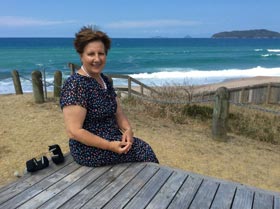 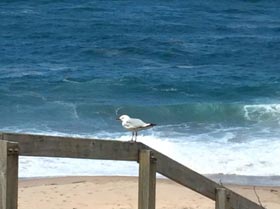 |